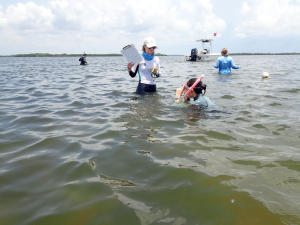Written by Jamila Roth, Ph.D. student, UF/IFAS School of Natural Resources and Environment
 This summer, I spent many sunny hours on the small island of Sandy Hook in Crystal River, FL, where I was conducting a field experiment for my Ph.D. research. My mission was to analyze how seagrass species diversity impacts seagrass resilience. I was searching for specific patches of seagrass and counting seagrass plants with my face inches from the seafloor.
This summer, I spent many sunny hours on the small island of Sandy Hook in Crystal River, FL, where I was conducting a field experiment for my Ph.D. research. My mission was to analyze how seagrass species diversity impacts seagrass resilience. I was searching for specific patches of seagrass and counting seagrass plants with my face inches from the seafloor.
About the Experiment
Seagrass meadows provide a variety of economic, cultural, and ecological benefits. As a foundation species, these plants reduce erosion, improve water quality and clarity, sequester carbon, and support diverse fish and invertebrate species (including endangered species, charismatic megafauna, and fishery species). This means that seagrasses support fishery production and recreational activities, including snorkeling and recreational fishing, which all boost local economies.
With environmental conditions changing rapidly due to climate change, coastal development, and nutrient loading, seagrass abundance is declining in many regions locally and globally. The response of plant communities to disturbances depends on their diversity, both in terms of species diversity and genetic diversity. For seagrasses, the role of genetic diversity is well established, but fewer studies have investigated the role of species diversity. In this study, we used seagrasses in the northern Gulf of Mexico as a model system to understand the role of species diversity in ecosystem resilience.
Seagrass meadows along the Gulf Coast of Florida often contain multiple seagrass species, making this an ideal location to investigate the effects of seagrass species diversity. Warming temperatures will indirectly impact Gulf of Mexico seagrasses through tropicalization (i.e. migration of tropical species away from the equator), with growing populations of herbivorous parrotfish, green turtles, and manatees resulting in greater grazing pressure on seagrasses. To investigate how seagrass species diversity influences seagrass resilience to increased grazing pressure, we conducted a manipulative field experiment in Crystal River, FL where we simulated green turtle grazing in plots containing one, two, three, and four different seagrass species. Through this experiment, we aimed to improve our understanding of how seagrass species diversity impacts ecosystem services, functions, and stability, as this knowledge is important for designing effective seagrass management and restoration strategies. Planting diverse seagrass assemblages could provide an important tool for increasing the resilience of restored seagrass meadows.

A Day in the Field
Armed with scissors, rulers, and marking flags, I headed out to my experiment site every 2 weeks with a group of amazing researchers who were ready to spend an entire day splashing in the seagrasses. In each of the 54 15-cm by 15-cm plots, we would count the total number of seagrass plants and measure their heights. After recording the data, we would use scissors to mimic green turtle grazing, pretending that the scissors were green turtle beaks hungrily chomping on seagrass plants and clipping the seagrasses to a height of 2 cm in half of the plots. By pairing each plot that we clipped with an unclipped control plot, we were able to compare whether the plants responded differently to the simulated grazing depending on the seagrass species identity and diversity.
Some days, we would find that the seawater was so murky that we struggled to find the flags marking the plots and could barely see the seagrasses we were counting. However, this just made us appreciate the beautiful days with clear water even more, when the work would go faster, and we could watch all the fish and crabs move throughout the seagrass.
A huge thank you to my lab mates and the entire NCBS community!
This experiment would not have been possible without all the field and experiment help from UF/IFAS NCBS summer interns, fellow graduate students, and biological scientists, all of whom dedicated their field skills and time to this experiment. I am so grateful for such a supportive community, with so many researchers that we’re always excited to wake up early and spend time with their faces deep in the lush Crystal River seagrass beds.
After learning many lessons about designing and conducting a seagrass field experiment, I am now excited to hunker down in the lab, process the samples, and learn more about the role of seagrass species diversity in seagrass resilience!
 0
0
